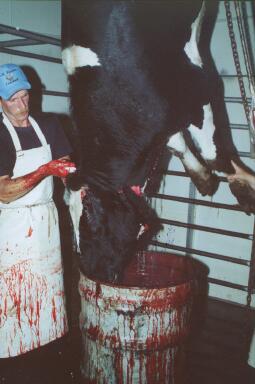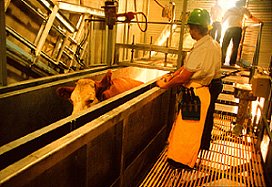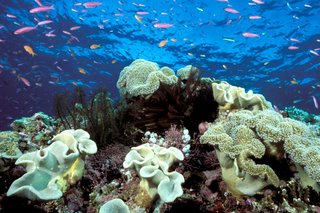
Abattoir: Slaughterhouses in the United States

"If slaughterhouses had glass walls, everyone
would be vegetarian."
Paul and Linda McCartney, 1996
"You have just dined, and however scrupulously
the slaughterhouse is concealed in the graceful
distance of miles, there is complicity."
Ralph Waldo Emerson, 1870
Poultry slaughtering process:http://www.hyfoma.com/en/content/food-branches-processing-manufacturing/meat-fish-shrimps/poultry-slaughtering/process_description.html
Pig Slaughtering:
http://www.hyfoma.com/en/content/food-branches-processing-manufacturing/meat-fish-shrimps/pig-slaughtering/process_description.html
Video on treatment of different animals in factory farms and in slaughterhouses: http://www.animalz.makessense.co.uk/articles/322.html

Does milk do a body good? What about Dairy Cows??
MILK SUCKS ...
FOR ANIMALS:
”Corporate-owned factories where cows are warehoused in huge sheds and treated like milk machines have replaced most small family farms. With genetic manipulation and intensive production technologies, it is common for modern dairy cows to produce 100 pounds of milk a day— 10 times more than they would produce in nature. To keep milk production as high as possible, farmers artificially inseminate cows every year. Growth hormones and unnatural milking schedules cause dairy cows' udders to become painful and so heavy that they sometimes drag on the ground, resulting in frequent infections and overuse of antibiotics. Cows— like all mammals— make milk to feed their own babies— not humans.
Male calves, the "byproducts" of the dairy industry, endure 14 to 17 weeks of torment in veal crates so small that they can't even turn around. Female calves often replace their old, worn-out mothers, or are slaughtered soon after birth for the rennet in their stomachs (an ingredient of most commercial cheeses). They are often kept in
tiny crates or tethered in stalls for the first few months of their lives, only to grow up to become "milk machines" like their mothers.”
FOR THE ENVIRONMENT:
”Cow's milk is an inefficient food source. Cows, like humans, expend the majority of their food intake simply leading their lives. It takes a great deal of grain and other foodstuffs cycled through cows to produce a small amount of milk. And not only is milk a waste of energy and water, the production of milk is also a disastrous source of water pollution. A dairy cow produces 120 pounds of waste every day -- equal to that of two dozen people, but with no toilets, sewers, or treatment plants.
In Lancaster County, Pa., manure from dairy cows is destroying the Chesapeake Bay, and in California, which produces one-fifth of the country's total supply of milk, the manure from dairy farms has poisoned vast expanses of underground water, rivers, and stream
s. In the Central Valley of California, the cows produce as much excrement as a city of 21 million people, and even a smallish farm of 200 cows will produce as much nitrogen as in the sewage from a community of 5,000 to 10,000 people, according to a U.S. Senate report on animal waste.”
FOR YOUR HEALTH:
”Dairy products are a health hazard. They contain no fiber or complex carbohydrates and are laden with saturated fat and cholesterol. They are contaminated with cow's blood and pus and are frequently contaminated with pesticides, hormones, and antibiotics. Dairy products are linked to allergies, constipation, obesity, heart disease, cancer, and other diseases.
The late Dr. Benjamin Spock, America's leading authority on child care, spoke out against feeding cow's milk to children, saying it can cause anemia, allergies, and insulin-dependent diabetes and in the long term, will set kids up for obesity and heart disease, America's number one cause of death.
And dairy products may actually cause osteoporosis, not prevent it, since their high-protein content leaches calcium from the body. Population studies, backed up by a groundbreaking Harvard study of more than 75,000 nurses, suggest that drinking milk can actually cause osteoporosis (Information taken from http://www.notmilk.com/tudrmac.html)."
Americans need to take their own health as well as animal welfare into consideration. We have a culture of consumption, but what are we consuming, how is it raised, what is it fed, how is it killed? We cannot stand by blindly and say, I didn’t know, I don’t want to know. With all things, we have an obligation to step forth and seek some knowledge about the world we live in and the role we play in it.
Slaughterhouse Design:

The design of slaughterhouses was largely influenced in the 1970’s by Dr. Temple Grandin. Her work was an effort to make the corrals and holding pens more humane and less stressful for the animals (which in the end can speed productivity). She was interested in patterns and flow and she used animal psychology to develop corrals with long sweeping curves so that the animals cannot see what lies ahead but focuses on the animal in front of it. It is thought that 54% of the slaughterhouses in the US are designed with these principles.
These attempts are worthwhile; however by looking into the current process in the
slaughterhouses, this is not enough. It is my belief that these industries are too
large and mechanized to ever be humane to the individual animal being “processed.”
While it is not feasible for everyone to order their meat from small farms or to farm
themselves, and while we in the US consume large quantities of meat “This year, 280
million Americans will each consume 36 animals. Thirty-four of those creatures will
have wings. One of those creatures will moo. One will oink,” slaughterhouses must
continue to meet our demand.
For me personally this is not enough. I don’t disagree
ethically with consuming animals, but I heavily disagree with the packaged way they
are provided us and the process and lives the animals must bear out. It is important
to me the quality of life the animal was able to live, and the way that it was killed.
I have lived on a small farm and I have seen animals slaughtered and I have never had a
problem until I looked further into how most animals are treated and processed for our
BBQs. I think seeing and understanding even humane animal killing will limit your
consumption, will give you an understanding of the animal and the life that must be
taken for you, and will give you pause to appreciate that life and consider your
consumption.
We are desensitized by fluffy pictures of chickens and neat packaging, desensitized
because although we know there is blood and a dead animal inside, it is almost as if
it is nothing, it gives us no thought, no pause, no conscience, no restraint. I
feel that Native Americans had it right when they were responsible for the death of
the animal and they prayed over them in gratitude for their sacrifice. There is no
gratitude in our society, just gluttony and ignorance. People keep saying, “Oh God, I
don’t want to know, and that’s soo gross. Just don’t tell me, I don’t want to know.”
For me, this has been a serious dillema. The concept taken ethically seems simple and direct action
swift, yet when taking into account uprbringing, norms and pure gut desires, the challenge can be great.
At times I almost feel that the organic and free range option has been a ploy to capitalists to
sound friendlier, make the mea tindustry somehow fluffier and more humane. They offered
a sidepath down which you could feel good about yourself -but I'm not so sure it's any different.
In its deception it's worse because mindful consumers become placid as we are thrown the free-range
token on which our conscience can rest. Subdued and quieted, the process can continue with
everyone feeling a little better about themselves, well, except the anmials, and possibly the
workers and their families who no doubt by their meat off the paycheck and yet suffer from the
fallout of this line of work. Organically certified is not enough, the animals are all raised in the same
way, and free range or not, they die by the same process in the same slaughterhouses as any
run of the mill beast with hormones. They are transported in open crates and pried screaming off
frozen truck walls and floors.
Perhaps we should push for decentralized, smaller farming and family farmed packing operations.
Perhaps we should take control of our spending power and our stomachs as we look at what our
diet is doing, what it's actually costing. If we consider ourselves carnivores tha tin the cycle of life
have the capacity and the righ to eat meat, then we should eat it knowing that it was raised under
humane conditions with a quality of life outside its gorging fat cells. If we have any sense in Kharma, we should be praying that
whateve happens, we don't come back a farm animal. Through those eyes, we might get a better glimpse of the
industry than we bargained for. I used to think that moderation was enough, but that seems another
myth that in an ethical world might be tolerable, but that today simply enables the madness.
"If slaughterhouses had glass walls, everyone
would be vegetarian."
Paul and Linda McCartney, 1996
It’s time more people speak out and seek the knowledge for themselves; its time we look inside the slaughterhouse and stop pretending that we can do nothing and it’s better not to know. Gail Eisnitz has done many years of work herself and has given us all a good start.

Gail finishes the chapter by quoting Gerald Kuester of USDA:
"There are about 50 points during processing where cross-contamination can occur. At the end of the line, the birds are no cleaner than if they had been dipped in a toilet."
Here is a link to more information from the HFA, the Humane Farming Association :
http://www.hfa.org/join/index.html
 for new and inexperienced divers. Cruise ships unload hundreds passengers to
for new and inexperienced divers. Cruise ships unload hundreds passengers to  enjoy pristine areas and
enjoy pristine areas and













